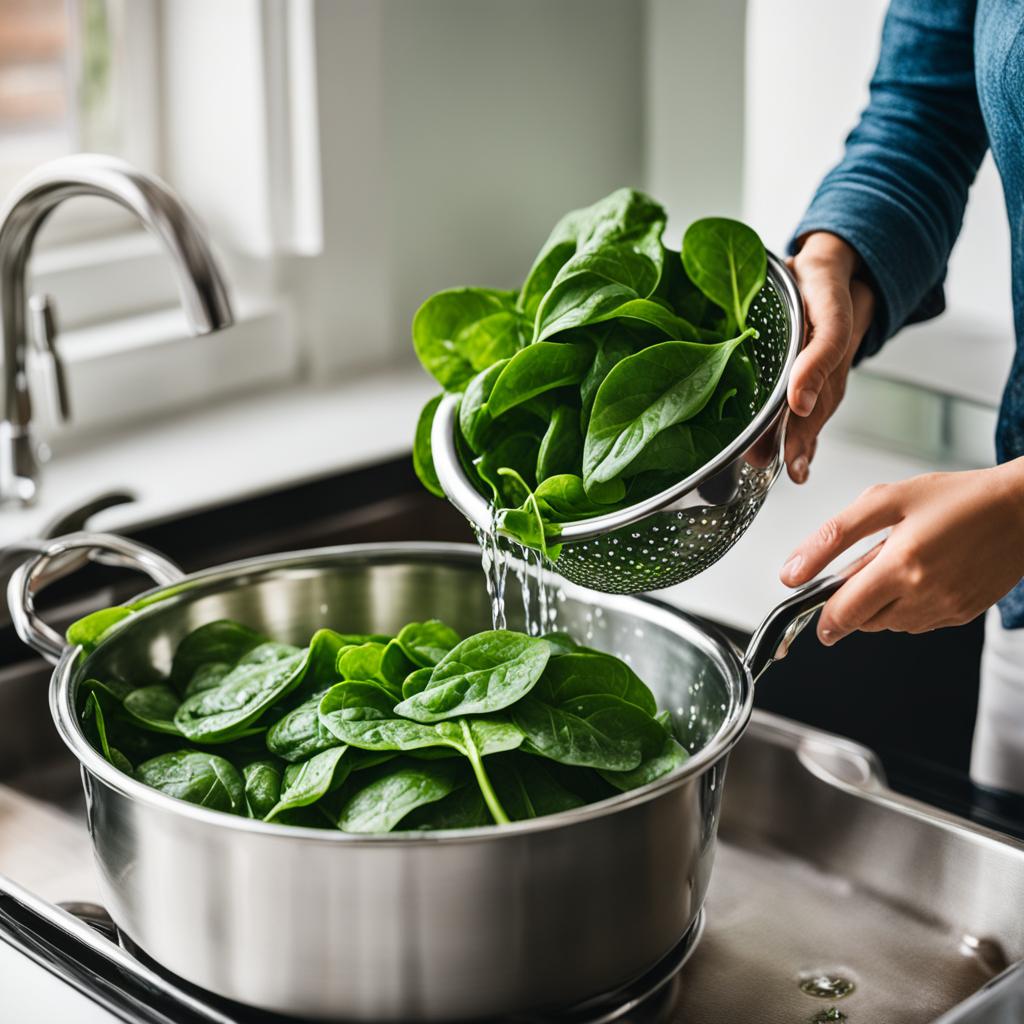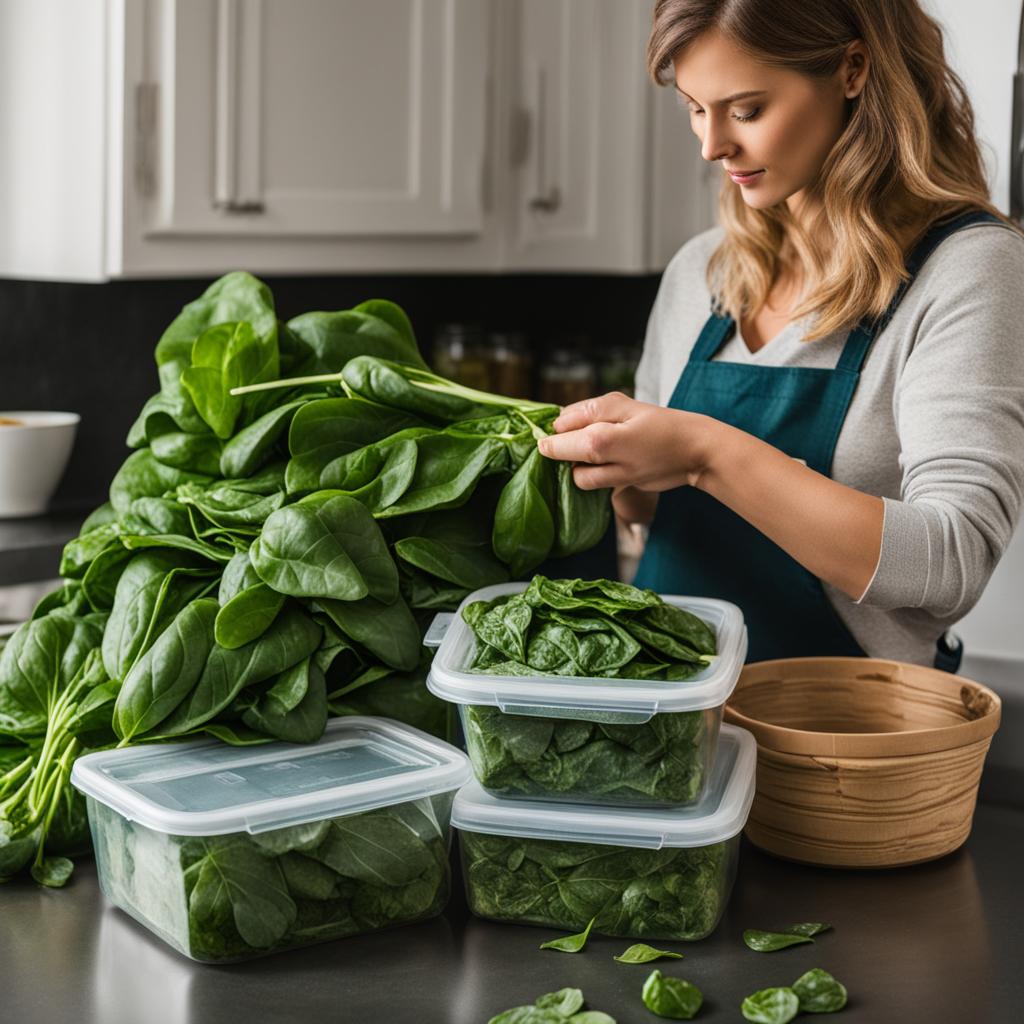Spinach is a popular leafy green vegetable that is known for its health benefits and versatility in cooking. However, like any perishable food, spinach can spoil if not stored properly. In this article, I will share some helpful tips on how to determine if your spinach has gone bad, ensuring that you always enjoy fresh and safe greens.
Proper storage and handling are key to preserving the freshness of spinach. By following these tips, you can make the most of this nutritious vegetable:
Key Takeaways:
- Check for visual signs of spoilage such as sliminess, discoloration, and foul odor.
- Store spinach in a tightly sealed container in the refrigerator’s crisper drawer to maintain the right temperature and moisture levels.
- Avoid overcrowding the fridge and keep spinach away from ethylene-producing fruits.
- Revive slightly wilted spinach by soaking it in ice water for a few minutes.
- Always wash spinach thoroughly before using it to remove dirt, pesticides, and bacteria.
How to Store Spinach So It Stays Fresh
Proper storage is key to keeping spinach fresh. Moisture is the biggest enemy, so make sure to store spinach in a tightly sealed container to prevent the leaves from breaking down and becoming slimy. The crisper drawer of the refrigerator is the best place to store spinach, as it provides the right temperature and moisture levels. Avoid overcrowding the fridge, as this can limit airflow and cause the spinach to spoil faster. Also, keep spinach away from ethylene-producing fruits like apples and pears, as ethylene can speed up the spoiling process.
Table: Best Practices for Storing Spinach
| Storage Method | Tips |
|---|---|
| Tightly sealed container | Prevents moisture buildup |
| Crisper drawer of the refrigerator | Provides optimal temperature and moisture levels |
| Avoid overcrowding | Allows for proper airflow |
| Keep away from ethylene-producing fruits | Prevents accelerated spoilage |
By following these storage tips, you can extend the freshness of your spinach and reduce food waste. Remember to always check the leaves for any signs of spoilage before consuming, and discard any spinach that has become slimy, discolored, or has a foul odor.
How to Tell If Spinach Is Bad: Visual Signs
When it comes to determining if your spinach has gone bad, there are several visual signs to look out for. By examining the color, texture, and smell of the spinach, you can quickly assess its freshness. Here are some key indicators:
Discoloration:
Fresh spinach should have bright green, crispy leaves. If you notice any yellow, brown, or black discoloration, it’s a clear sign that the spinach has started to spoil. Additionally, pay attention to any wilted leaves, especially if they feel slimy to the touch. These are also signs of spoilage and should be discarded.
Texture:
Another visual clue is the texture of the spinach leaves. Fresh spinach should be firm and crisp. If the leaves feel limp, mushy, or slimy, it’s a strong indication that the spinach is no longer good to eat. Wilted and slimy leaves are a result of bacterial growth, which can make the spinach unsafe to consume.
Smell:
A musky or sour odor is a telltale sign that spinach has gone bad. If you detect any unpleasant smells coming from your spinach, it’s a clear indication that it should be discarded. A fresh batch of spinach should have a neutral or slightly earthy smell.
Mold:
Mold growth on spinach leaves is a definite sign of spoilage. If you notice any fuzzy, green, or black spots on the leaves, it’s important to discard the spinach immediately. Consumption of moldy spinach can lead to foodborne illnesses and should be avoided at all costs.
By paying attention to these visual signs, you can determine if your spinach has gone bad and make an informed decision about whether to consume or discard it. Remember, it’s better to be safe than sorry when it comes to food safety!
| Visual Signs of Bad Spinach | Description |
|---|---|
| Discoloration | Yellow, brown, or black leaves indicate spoilage |
| Texture | Wilted, mushy, or slimy leaves are signs of bacterial growth |
| Smell | Musky or sour odor indicates spoilage |
| Mold | Fuzzy, green, or black spots on the leaves indicate mold growth |
How to Check the Quality of Spinach Before Buying
When it comes to buying spinach, it’s important to know how to check its quality to ensure you’re getting the freshest and most nutritious leaves. Here are some tips on what to look for:
Visual Inspection
- Check for Moisture: Excessive moisture on the packaging can indicate that the spinach is already starting to wilt and spoil.
- Look for Bruising: Bruised or damaged leaves can release moisture and lead to faster spoilage. Choose spinach with minimal bruising.
- Inspect for Dark Spots: Dark spots on the leaves can be a sign of poor quality. Opt for spinach with vibrant green leaves, free from any discoloration.
Sensory Evaluation
- Smell the Spinach: Fresh spinach should have a mild, earthy scent. If it has a foul or unpleasant odor, it is likely past its prime.
- Feel the Texture: Gently touch the leaves to ensure they are firm and crisp. Avoid spinach with wilted or slimy leaves, as these are signs of spoilage.
By checking these visual and sensory aspects, you can make an informed decision when purchasing spinach and ensure you’re getting the best quality for your recipes.
| Visual Inspection | Sensory Evaluation |
|---|---|
| Moisture on packaging | Smell the spinach |
| Bruising or damage | Feel the texture |
| Dark spots |
“Choosing spinach with vibrant green leaves, minimal bruising, and no dark spots ensures you’re selecting the freshest and highest-quality spinach.”
How to Store Spinach to Prolong Freshness
Proper storage is crucial in prolonging the freshness of spinach. By following these storage tips, you can ensure that your spinach stays crisp and delicious for a longer period.
Refrigeration
One of the most important factors in storing spinach is refrigeration. Place your spinach in a tightly sealed container to prevent moisture from entering and causing wilting. It is recommended to use the crisper drawer of your refrigerator, as it provides the optimal temperature and humidity levels for leafy greens.
Moisture Control
Excess moisture can lead to the rapid deterioration of spinach, so it’s important to control the moisture levels. Before storing, wash and thoroughly dry the leaves to remove any surface moisture. This will prevent the leaves from becoming soggy and slimy.
Avoid Ethylene-Producing Fruits
Ethylene is a natural gas that accelerates the ripening process and can cause vegetables to spoil faster. Keep your spinach away from ethylene-producing fruits like apples and pears to prolong its freshness.
| Storage Tips | Benefits |
|---|---|
| Wash and dry spinach before storing | Removes excess moisture and prevents wilting |
| Store in a tightly sealed container in the refrigerator | Optimal temperature and humidity levels for leafy greens |
| Avoid storing near ethylene-producing fruits | Prevents accelerated spoilage |
By following these simple storage tips, you can ensure that your spinach remains fresh and vibrant, ready to be used in your favorite recipes. Proper refrigeration, moisture control, and avoiding ethylene-producing fruits are key factors in prolonging the shelf life of spinach. By implementing these strategies, you can enjoy the nutritional benefits of spinach for a longer period.
Tips for Using Wilted Spinach
When you find yourself with wilted spinach in your refrigerator, don’t despair! While it may not be suitable for raw consumption, wilted spinach can still be a valuable ingredient in your cooking. With a few simple techniques, you can transform it into flavorful dishes that are both delicious and nutritious.
To revive wilted spinach, start by giving it a five-minute soak in ice water. This process helps to rehydrate the leaves and restore their texture. After the soak, remove the spinach from the water and pat it dry before using it in your desired recipe. Whether you’re making sautés, quiches, pastas, or using it as a side dish, wilted spinach adds a unique flavor profile and a boost of nutrients.
Experiment with different cooking methods to make the most of wilted spinach. Sauté it with garlic and olive oil for a quick and tasty side dish, or add it to your favorite pasta sauce for an extra dose of greens. You can also incorporate wilted spinach into omelettes, frittatas, or even homemade pizza. The possibilities are endless!
Remember, using wilted spinach in your cooking not only helps reduce food waste but also adds depth of flavor and texture to your dishes. So the next time you come across a bunch of slightly wilted spinach, don’t throw it away. Get creative in the kitchen and enjoy the deliciousness it can bring to your meals!
The Dangers of Eating Spoiled Spinach
Eating spoiled spinach can have serious consequences for your health. When spinach goes bad, it can become contaminated with harmful bacteria such as E. coli and salmonella, which can lead to foodborne illnesses. These bacteria can cause a range of symptoms, including diarrhea, nausea, stomach cramps, and fever. In some cases, foodborne illnesses can be severe and even life-threatening, especially for individuals with weakened immune systems, children, and the elderly.
Spinach is particularly susceptible to bacterial contamination due to its high moisture content and the ease with which bacteria can grow on its leaves. When spinach is improperly stored or reaches its expiration date, bacteria can multiply rapidly, leading to the production of toxins that can make you sick. Therefore, it is crucial to be aware of the visual signs of spoilage and to always discard spinach that has gone bad.
“When spinach becomes slimy, discolored, or has a foul odor, it is a clear indication that it has spoiled and should not be consumed. Don’t take any chances with your health – always err on the side of caution and throw out any spinach that shows these signs of spoilage.”
By understanding the dangers of eating spoiled spinach, you can take the necessary precautions to protect yourself and your loved ones from foodborne illnesses. It is always better to be safe than sorry when it comes to consuming perishable foods like spinach, so make sure to check for signs of spoilage before eating or cooking with it.
| Illness | Symptoms |
|---|---|
| E. coli | Diarrhea, abdominal pain, vomiting, fever |
| Salmonella | Diarrhea, fever, abdominal cramps |
| Campylobacter | Diarrhea, fever, abdominal pain, nausea |
| Listeria | Fever, muscle aches, headache, confusion, loss of balance |
Preventing Foodborne Illnesses
To reduce your risk of foodborne illnesses from spoiled spinach and other perishable foods, it is important to follow these guidelines:
- Buy spinach from reputable sources and check for signs of freshness.
- Properly store spinach in the refrigerator at temperatures below 40°F (4°C).
- Wash your hands thoroughly before handling spinach.
- Use clean utensils and cutting boards when preparing spinach.
- Ensure that spinach is cooked to the recommended internal temperature to kill any bacteria that may be present.
By taking these precautions and being vigilant about food safety, you can enjoy the nutritional benefits of spinach without putting your health at risk.
How to Properly Wash Spinach
Ensuring the cleanliness of spinach is crucial for food safety. Even if the packaging claims that the spinach has been prewashed, it is still recommended to rinse it again. Washing spinach helps remove any residual dirt, pesticides, or bacteria that may be present on the leaves, including harmful pathogens like E. coli and salmonella. To properly wash spinach, follow these steps:
- Start by rinsing the spinach under cold running water. This will help remove any initial debris or dirt.
- Gently rub the leaves with your hands to further remove any remaining dirt or pesticide residue. Pay extra attention to the crevices and stems of the leaves.
- If desired, use a salad spinner to remove excess moisture from the spinach. Place the spinach in the spinner, give it a few spins, and then pat it dry with a clean kitchen towel or paper towels.
It’s important to note that washing spinach too far in advance can cause it to wilt and spoil faster. It is best to wash spinach just before using it in your recipes.
“Properly washing spinach helps remove any residual dirt, pesticides, or bacteria that may be present on the leaves, including harmful pathogens like E. coli and salmonella.”
Why is proper washing important for food safety?
Properly washing spinach is essential for food safety because leafy greens, including spinach, have been associated with multiple foodborne illness outbreaks in the past. Bacteria like E. coli and salmonella can contaminate spinach, causing gastrointestinal issues and other health problems if consumed. By thoroughly washing spinach, you can minimize the risk of ingesting these harmful pathogens and protect yourself and your family from potential illness.
| Benefits of Proper Washing | Risks of Improper Washing |
|---|---|
|
|
By following proper washing techniques, you can ensure that your spinach is clean and safe to consume, minimizing the risk of foodborne illnesses and promoting a healthy eating environment.

The Impact of Storage on Spinach Shelf Life
Proper storage techniques play a crucial role in determining the shelf life of spinach. Factors such as refrigeration, packaging, and oxygen levels can significantly impact the freshness and longevity of this leafy green. Understanding how these factors affect spinach can help you maximize its shelf life and minimize food waste.
Refrigeration is essential for maintaining the freshness of spinach. Cold temperatures help slow down the natural decomposition process and preserve the quality of the leaves. Storing spinach in a tightly sealed container in the refrigerator helps maintain its freshness for a longer period. Additionally, proper refrigeration helps prevent moisture buildup, which can lead to wilting and spoilage.
The packaging of spinach also plays a role in extending its shelf life. Commercially packaged spinach often uses modified atmosphere packaging, which manipulates the oxygen levels around the leaves. This packaging technique helps slow down the deterioration of the spinach and extends its freshness. When purchasing spinach, look for products that have been properly packaged to ensure a longer shelf life.
Controlling the oxygen levels around spinach is crucial for preventing spoilage. Exposure to oxygen accelerates the breakdown of the leaves and promotes the growth of bacteria and mold. By storing spinach in a tightly sealed container and using packaging that minimizes oxygen exposure, you can prolong its shelf life and maintain its quality.
| Factors | Impact |
|---|---|
| Refrigeration | Slows down decomposition and preserves freshness |
| Packaging | Modified atmosphere packaging extends shelf life |
| Oxygen Levels | Controlled environment prevents spoilage |
By understanding the impact of storage on spinach shelf life, you can take the necessary steps to ensure your spinach stays fresh for longer. Remember to store spinach in a tightly sealed container in the refrigerator, choose products with proper packaging, and control the oxygen levels around the leaves. These simple storage practices can help you minimize food waste and enjoy fresh spinach for all your culinary needs.
Tips for Selecting Fresh Spinach at the Store
When it comes to selecting fresh spinach at the store, a visual inspection is key. By paying attention to certain factors, you can ensure that you’re choosing the best quality spinach for your meals. Here are some tips to help you select fresh spinach:
- Look for bright green, crispy leaves: Fresh spinach should have vibrant, green leaves that are crisp to the touch. Avoid spinach that appears wilted or has yellow, brown, or black discoloration.
- Check for signs of moisture: Excess moisture on the packaging or inside the bag can be a sign that the spinach has started to spoil. Condensation or wetness can lead to faster deterioration.
- Avoid damaged leaves: Inspect the spinach for any bruised or broken leaves. Damaged leaves can release moisture and accelerate spoilage. Choose spinach with intact, undamaged leaves.
By following these tips, you can confidently select fresh spinach that will stay fresh and delicious for longer.
| Visual Signs of Fresh Spinach | Visual Signs of Bad Spinach |
|---|---|
| Bright green, crispy leaves | Yellow, brown, or black discoloration |
| Firm texture | Wilted or slimy leaves |
| No signs of moisture or condensation | Excess moisture or condensation |
| No damage on the leaves | Bruised or broken leaves |
Table: Visual signs of fresh and bad spinach
Remember, selecting high-quality spinach at the store is the first step towards enjoying fresh and nutritious meals. By choosing the freshest spinach available and ensuring it is free from damage and excess moisture, you can enhance the flavor and nutritional value of your dishes.
How to Revive Slightly Wilted Spinach
If you find that your spinach is slightly wilted, don’t worry! There is a simple trick to bring it back to life and restore its texture. All you need is some ice water and a few minutes of soaking time. The ice water soak method can rehydrate the leaves and make them crisp again, ensuring you can still enjoy your spinach in salads, smoothies, or cooked dishes.
To revive the wilted spinach, start by filling a bowl with cold water and adding ice cubes. Submerge the wilted spinach in the ice water and let it soak for about five minutes. The cold temperature of the water will help rehydrate the leaves and restore their texture. After the soak, remove the spinach from the water and gently pat it dry with a clean towel or paper towel. Your spinach is now ready to be used in your favorite recipes!
This simple method of reviving wilted spinach is a great way to reduce food waste and ensure that you can still enjoy the flavors and nutritional benefits of this leafy green. So, the next time you come across slightly wilted spinach in your fridge, don’t throw it away. Give it a refreshing ice water soak, and it will be good as new!
Table: Reviving Wilted Spinach – Step by Step
| Step | Description |
|---|---|
| 1 | Fill a bowl with cold water. |
| 2 | Add ice cubes to the bowl to make the water icy cold. |
| 3 | Submerge the wilted spinach in the ice water. |
| 4 | Let the spinach soak in the ice water for about five minutes. |
| 5 | Remove the spinach from the water and gently pat it dry. |
| 6 | Use the revived spinach in your desired recipes. |
Tips for Preventing Spinach from Going Bad Quickly
When it comes to keeping spinach fresh and preventing spoilage, proper storage techniques are key. Here are some tips to help you extend the shelf life of your spinach:
Storage Techniques:
- Store spinach in a tightly sealed container in the refrigerator to minimize moisture and prevent wilting.
- Avoid overcrowding the fridge, as this restricts airflow and can lead to faster spoilage.
- Ensure proper airflow around the spinach by not packing other items too tightly around it.
Temperature Control:
Keep the refrigerator temperature at or below 40°F (4°C) to maintain optimal freshness. Fluctuations in temperature can accelerate spoilage, so it’s important to keep the fridge consistently cool.
Proper Airflow:
Allowing for proper airflow in the refrigerator is essential for keeping spinach fresh. Make sure there is enough space between items to allow cold air to circulate freely, preventing the buildup of excess moisture.
Avoiding Ethylene Exposure:
Keep spinach away from ethylene-producing fruits, such as apples and pears, as exposure to ethylene can speed up the spoiling process. Store spinach separately or in a different compartment of the refrigerator to prevent cross-contamination.
By following these storage techniques, maintaining the proper temperature and airflow, and avoiding ethylene exposure, you can significantly prolong the freshness of your spinach and minimize food waste.

The Importance of Washing Spinach Before Use
When it comes to ensuring food safety, washing spinach before use is of utmost importance. While prewashed spinach may seem convenient, it’s always a good idea to give it an extra rinse to remove any residual dirt, pesticides, or bacteria that may be present on the leaves. Spinach has been a common source of contamination, with recalls due to bacteria like E. coli and salmonella.
To properly wash spinach, simply rinse it under cold running water, gently rubbing the leaves to remove any debris. Taking this extra step can significantly reduce the risk of consuming harmful bacteria and ensure that your spinach is clean and safe to eat. Even if you’re planning to cook the spinach, washing it beforehand is still recommended to maintain optimal food safety.
“Washing spinach before use helps remove residual dirt, pesticides, and harmful bacteria like E. coli and salmonella.”
By incorporating this simple step into your food preparation routine, you can enjoy the nutritional benefits of spinach while minimizing any potential health risks. Prioritizing food safety is essential, and washing spinach is a crucial part of ensuring the overall safety and quality of your meals.
The Benefits of Washing Spinach:
- Removes residual dirt and debris.
- Reduces the risk of consuming harmful bacteria.
- Improves overall food safety and quality.
- Ensures clean and safe spinach for consumption.
Guidelines for Washing Spinach:
- Rinse spinach under cold running water.
- Gently rub the leaves to remove debris.
- Thoroughly dry the spinach before use.
- Wash even prewashed spinach to maintain food safety.
By following these guidelines and prioritizing food safety, you can confidently incorporate spinach into your diet, knowing that it has been properly washed and is safe for consumption.
Tips for Using Spinach in Cooking
Spinach is a versatile leafy green that can elevate the flavor of various dishes. Whether you’re a seasoned chef or an amateur cook, incorporating spinach into your recipes can add a nutritious and delicious element. Here are some tips and ideas for cooking with spinach:
1. Salads and Smoothies:
Spinach is a fantastic addition to salads and smoothies. Its mild flavor pairs well with a variety of ingredients, such as fresh fruits, nuts, and cheese. You can create a refreshing spinach salad by tossing it with some strawberries, feta cheese, and a balsamic vinaigrette. Alternatively, blend spinach with bananas, berries, and almond milk for a nutritious green smoothie.
2. Sautes and Stir-Fries:
Adding spinach to sautes and stir-fries is a great way to incorporate it into a hot dish. Sauted spinach with garlic and olive oil makes a simple yet flavorful side dish. You can also pair spinach with other vegetables like bell peppers, mushrooms, or onions for a colorful and nutritious stir-fry. The slight bitterness of spinach can balance out the flavors in these dishes.
3. Pasta and Quiches:
Spinach is a versatile ingredient that can enhance the taste of pasta dishes and quiches. Toss cooked pasta with sauted spinach, cherry tomatoes, and Parmesan cheese for a quick and satisfying meal. In quiches, spinach provides a vibrant and earthy flavor. Combine it with eggs, cheese, and your choice of vegetables or meat to create a savory and filling dish.
These are just a few examples of how you can use spinach in your cooking. Don’t be afraid to experiment and get creative with different recipes and techniques. Spinach’s versatility and nutritional profile make it an excellent choice for adding flavor and enhancing the nutritional value of your meals.
Incorporate spinach into your culinary repertoire and enjoy the numerous health benefits it offers. Whether you’re using it in salads, sautes, or even smoothies, spinach is sure to add a burst of freshness and flavor to your dishes. Experiment with different cooking methods and recipes to discover your favorite ways to cook with this versatile leafy green.
Conclusion
In conclusion, understanding how to tell if spinach has gone bad is crucial for maintaining a safe and healthy diet. By following the freshness tips and storage techniques discussed in this article, you can ensure that you’re consuming fresh and safe spinach.
Remember to always check for visual signs of spoilage, such as discoloration, sliminess, or a foul odor. Properly storing spinach in a tightly sealed container in the refrigerator, away from ethylene-producing fruits, can help prolong its freshness.
Additionally, washing spinach thoroughly before use is essential for removing any dirt, pesticides, or bacteria that may be present. Taking these extra precautions will help minimize the risk of consuming spoiled greens and the associated dangers of foodborne illnesses.
By implementing these tips and techniques, you can confidently enjoy the nutritional benefits of spinach and incorporate it into a variety of delicious recipes. So go ahead and make spinach a regular part of your healthy eating routine!
FAQ
How can I tell if spinach has gone bad?
Look for visual signs such as yellow, brown, or black leaves, sliminess, and a foul odor.
How should I store spinach to keep it fresh?
Store spinach in a tightly sealed container in the refrigerator’s crisper drawer, away from ethylene-producing fruits.
What are the visual signs that indicate spinach is bad?
Discoloration, sliminess, a foul odor, and mold growth are all signs of spoiled spinach.
How can I check the quality of spinach before buying it?
Look for signs of moisture, bruising, or dark spots on the leaves.
How can I prolong the freshness of spinach?
Wash and thoroughly dry the leaves before storing them in a tightly sealed container in the refrigerator’s crisper drawer.
Can I still use wilted spinach?
Wilted spinach can be used in cooking as long as it hasn’t become slimy or developed a foul odor.
Are there any dangers associated with eating spoiled spinach?
Yes, spoiled spinach can contain harmful bacteria like E. coli and salmonella, which can cause foodborne illnesses.
How should I wash spinach before using it?
Rinse the spinach under cold running water, gently rubbing the leaves to remove dirt, pesticides, and bacteria. Use a salad spinner to remove excess moisture.
How does storage impact spinach shelf life?
Proper refrigeration, packaging, and handling by the consumer are all important factors in maintaining spinach’s freshness.
How can I select fresh spinach at the store?
Look for bright green, crispy leaves without wilting, discoloration, or damage. Avoid packages with excess moisture or condensation.
Can I revive slightly wilted spinach?
Yes, you can soak wilted spinach in ice water for five minutes to rehydrate the leaves and restore their texture.
How can I prevent spinach from going bad quickly?
Store spinach in a tightly sealed container in the refrigerator, avoid overcrowding the fridge, and handle the leaves with care to avoid damage.
Why is it important to wash spinach before use?
Washing spinach helps remove dirt, pesticides, and bacteria like E. coli and salmonella that may be present on the leaves.
What are some tips for using spinach in cooking?
Spinach is versatile and can be used in salads, smoothies, pastas, quiches, and more. It adds both nutrition and flavor to dishes.
Is there a conclusion to this article?
No, there is no conclusion in this article, only a summary of important points.
Source Links
- https://www.eatingwell.com/article/7960529/how-to-keep-spinach-from-getting-slimy/
- https://homecookbasics.com/how-to-tell-if-spinach-has-gone-bad/
- https://gingerdivine.com/how-to-tell-if-spinach-is-bad/
Related Recipes:
 How to Freeze Spinach? (Perfect Step-By-Step Guide)
How to Freeze Spinach? (Perfect Step-By-Step Guide)
 How to Tell if Pork is Bad: Identifying Spoiled Meat
How to Tell if Pork is Bad: Identifying Spoiled Meat
 Spotting Bad Lemons: What to Look For
Spotting Bad Lemons: What to Look For
 How to Tell if Strawberries Are Bad: Freshness Guide
How to Tell if Strawberries Are Bad: Freshness Guide
 Identifying a Bad Whole Turkey
Identifying a Bad Whole Turkey
 How to Tell if Raspberries Are Bad: Freshness Facts
How to Tell if Raspberries Are Bad: Freshness Facts
 Does Almond Milk Go Bad? How to Tell and Storage Tips.
Does Almond Milk Go Bad? How to Tell and Storage Tips.
 How to Tell if Jelly Has Gone Bad: Preserving Quality
How to Tell if Jelly Has Gone Bad: Preserving Quality







